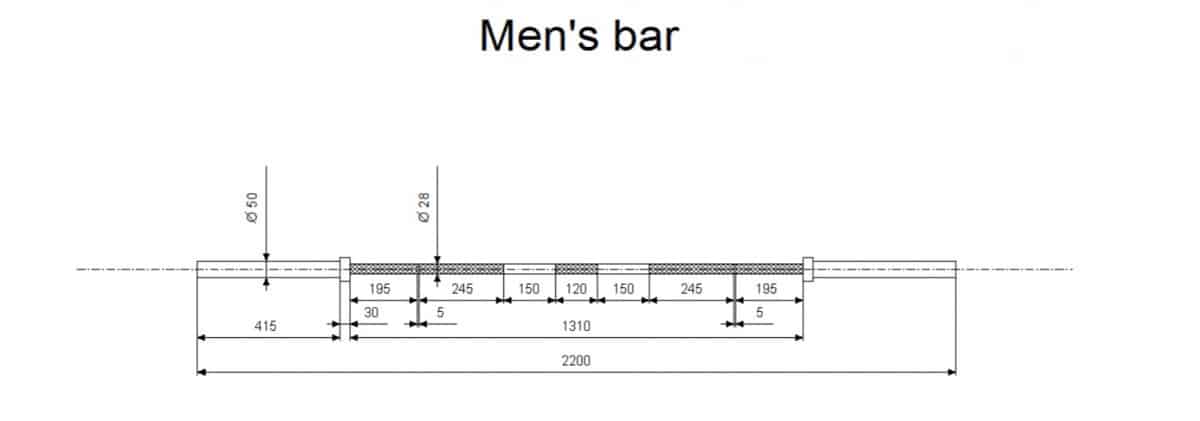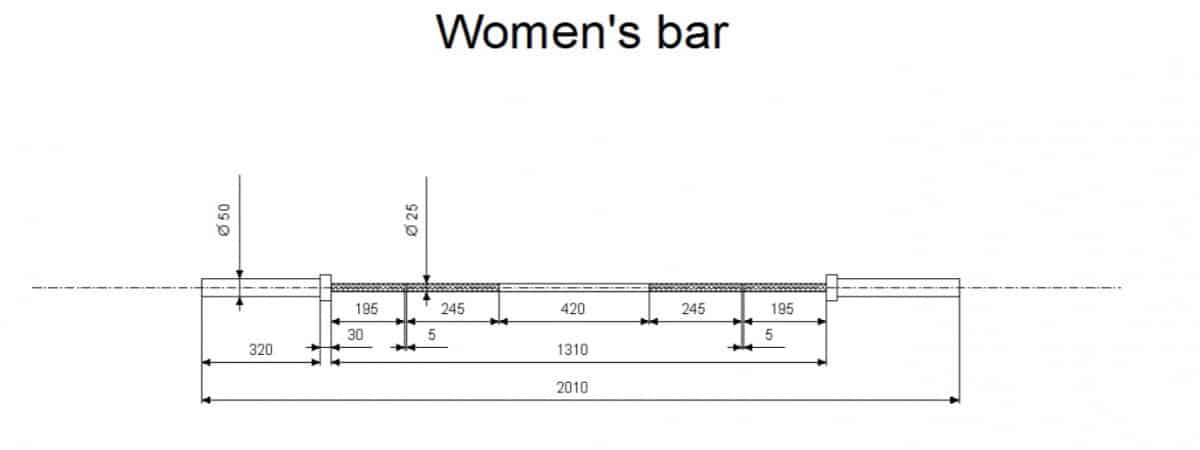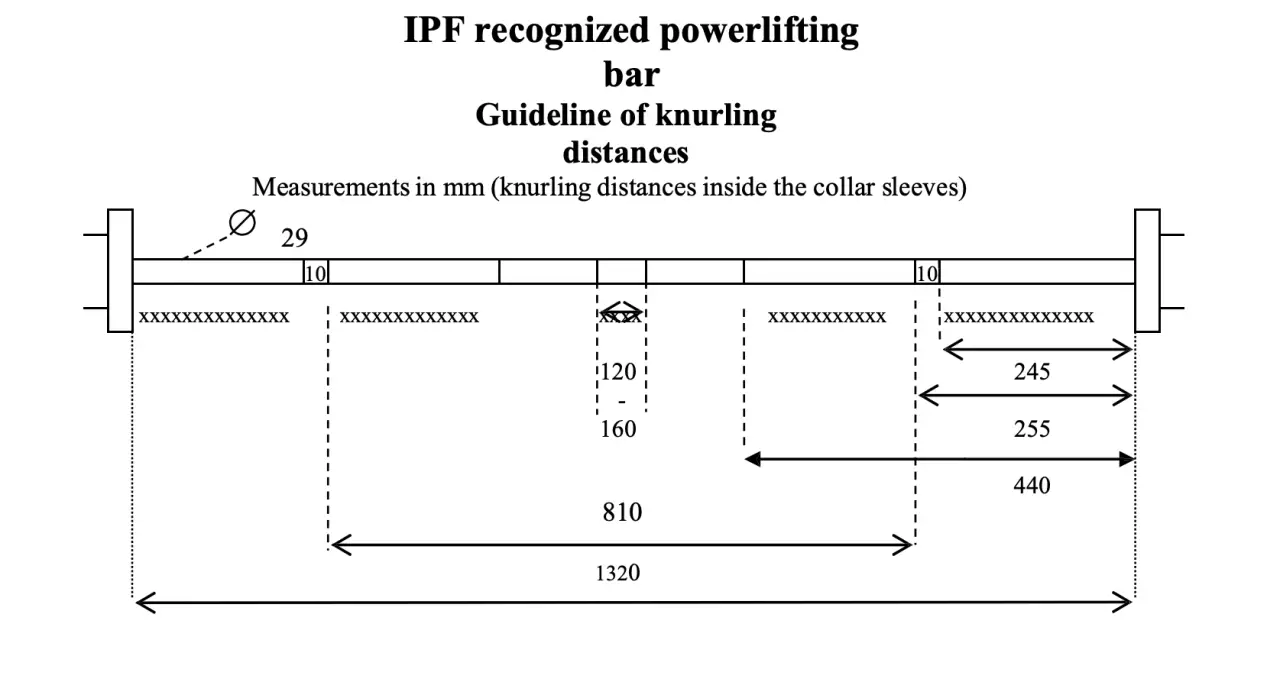With so many barbells out there, it can be hard to keep track of how big and heavy an Olympic barbell is. And it’s made more complicated because “Olympic barbell” can refer to different barbells. In this article, i’ll try to make things as easy as possible.
The standard Olympic barbell you’ll find in most gyms weighs 20 kg, is 220 cm long, and has a 28 mm diameter shaft which is 131 cm long. It features spinning sleeves which are 41.5 cm long and 50mm in diameter.
Sadly, things do get a bit more complicated than this. Below we’ll go into what Olympic really means in gym equipment land and which type has which dimensions.
Contents
Olympic Barbell Types
The standard Olympic barbell you can find in most commercial and home gyms is very closely related to the official men’s Olympic barbell. Which has the dimensions you can see above.
In gym equipment speak, an Olympic barbell is any bar that has 50mm diameter sleeves.
Technically the only real Olympic barbells would be the IWF-certified bars to be used in official competitions. But 99.9% of the “Olympic” barbells in the world aren’t that kind of barrel. Most barbells are a derivative of those official bars so their dimensions are still relevant.
There are 6 types of Olympic barbells we’ll get into in the rest of this post.
IWF Olympic Barbell Weights & Dimensions
First, let’s take a look at the weights and dimensions that IWF-certified barbells have to comply with. Most standard barbells are modeled after the men’s Olympic bar so they will be very close to these dimensions.

Picking the right barbell can be a bit confusing. Here is a guide that walks you through all the important factors in picking a barbell.
IWF Men’s Olympic Bar Weights and Dimensions
The IWF men’s Olympic barbell is a 20 kg bar made from chromed steel. It’s 220 cm long, with a 28 mm diameter shaft and 50 mm diameter sleeves. The shaft length is 131 cm. The loadable sleeve length is 41.5 cm while typically sporting a 190,000+ PSI tensile strength.

Let’s look at the men’s Olympic barbell and its specific dimensions:
| Specification | Measurement |
|---|---|
| Barbell Length | 220 cm (7.2 feet) |
| Shaft Length | 131 cm |
| Barbell Weight | 20 kg (44 lbs) |
| Bar Diameter | 28 mm |
| Sleeve Diameter | 49.8-50 mm |
| Loadable Sleeve Length | 41.5 cm (16.3 inches) |
| Center Knurling | Yes |
| Tensile Strength | Typically 190,000 PSI+ |
| Finish | Chromed Steel |
Precision in Dimensions and Weight
To achieve IWF certification, all dimensions and weights must adhere to an extremely tight tolerance range of +0.1% to -0.05%. This level of precision is challenging to attain, which is why certified bars are quite expensive. The tolerances are set so tight to keep things fair in competitions, even when using different barbells.
Non-Certified Barbell Consideration
In contrast, if you opt for a non-certified barbell with the same quoted dimensions and weights, there’s a likelihood that the tolerances are considerably broader. For people who aren’t training for an official competition, this really doesn’t matter so you can get away with using a much cheaper bar.
Looking for a good but affordable Olympic barbell for your home or garage gym? Find the best options here.
IWF Women’s Olympic Barbell Weight and Dimensions
Now let’s look at the women’s Olympic barbell. There are some similarities but also some differences.
The IWF women’s Olympic barbell is a 15 kg bar crafted from chromed steel. Its total length is 201 cm while the shaft length is 131 cm. It features 25 mm diameter shaft and 50 mm diameter sleeves. The loadable sleeve length is 30 cm, and it generally maintains a tensile strength of 190,000+ PSI.

| Specification | Measurement |
|---|---|
| Barbell Length | 201 cm (6.6 feet) |
| Shaft Length | 131 cm |
| Barbell Weight | 15 kg (33 lbs) |
| Bar Diameter | 25 mm |
| Sleeve Diameter | 49.8-50 mm |
| Loadable Sleeve Length | 30 cm (11.8 inches) |
| Center Knurling | No |
| Tensile Strength | Typically 190,000 PSI+ |
| Finish | Chromed Steel |
As you can see, the biggest difference between the women’s and the men’s bar is that it’s 5 kg lighter, is 19 cm shorter and the shaft has a 3 mm smaller diameter.
Suggested: Should you use a women’s Olympic barbell?
The shaft length is the same between both bars. So to make the total length shorter, the sleeves are cut a little.
Another difference you can’t see from the numbers above is the knurling (the cross-hatch pattern in the shaft). The men’s bar has a knurling patch in the middle of the barbell while the women’s bar doesn’t.
Non-Competition Olympic Barbells
There are plenty of barbells out there, probably even the majority, that are advertised as ‘Olympic’ but aren’t really IWF certified or could ever be certified. They often have wider tolerances in weight and dimensions than a certified bar but they are still very close in weight and dimensions to the originals.
These are generally mid-range to high-quality barbells but the specs are just a tiny bit different. Some of these changes are to save money but other things are changed to improve the bar for general purposes.
Not everyone is lifting Olympic style, many of us just do general fitness, bodybuilding, or powerlifting movements so the perfect general-purpose bar might look a little different.
Manufacturers can change the bars in different ways;
4-7 Foot Barbells
Then there are the barbells which are sold by the foot. These often stray even further from the official competition specs and except for the total length, you really have to check the specific specs of a certain bar to know what you’re getting.
These aren’t even pretending to be like competition bars, they just have 50mm sleeves that take Olympic plates. Some very cheap ones even have fixed sleeves that don’t spin.
These bars are generally available in lengths from 4′ to 7′ and some even have different shapes. Think about EZ curl, Safety squat, and cambered barbells. They often have “Olympic” sleeves but the rest of the bar is very different.
I’m focussing on the straight bars here. I’ve summarized the dimensions of the different lengths bar here but be aware that within a certain length barbell, there can be some variation in weight, shaft/sleeve length, and shaft diameter.
| Specification | 4′ Barbell | 5′ Barbell | 6′ Barbell | 7′ Barbell |
|---|---|---|---|---|
| Weight (kg/lbs) | 8.2 – 9.5 kg (18-21 lbs) | 11.3 -12.7 kg (25-28 lbs) | 12.7-15 kg (28-33 lbs) | 16-20.8kg (35-46 lbs) |
| Total Length (cm/in) | 119-122 cm (47″-48″) | 150- 152.4 cm (59-60″) | 182.88 cm (72″) | 203-220 cm (80″-86.6″) |
| Shaft Length (cm/in) | 78.75-83.8 cm / (31″-33″) | 89.9 – 101 cm (35.4″-39.8″) | 106- 132 cm (42″-52″) | 131-141.5 cm (51.6″-55.7) |
| Shaft Diameter (mm) | 25-28 mm | 28 mm | 28-30 mm | 28-30 mm |
| Sleeve Length (cm/in) | 17-20 cm (6.7-7.9″) | 24.75-26.6 cm (9.75″-10.5″) | 22.8-34.3 cm (9″-13.5″) | 41.5 cm (13.6-16.3″) |
You can see that while these bars look like Olympic barbells, their weights and dimensions can vary quite a bit.
As long as the bar can do what you need it to do, there isn’t really an issue but be aware that many of these x-feet bars aren’t very high quality. For low to medium-intensity home workouts, they’re fine but not for serious lifters.
IPF Barbell Dimensions
The International Powerlifting Federation (IPF) sets its own standards for barbells. While powerlifting is really not “Olympic lifting, the barbells they use take the same weight plates with 50mm hole so in some way they fall under the broad understanding of what an Olympic bar is.
They are actually heavily based on the IWF men’s bar with a few adjustments. The IPF specifications for barbells are actually much looser than the IWF’s ones, here are the required specs quoted directly from the IPF site:
“The bar shall be straight and well knurled and grooved and shall conform to the following dimensions:
- Total overall length not to exceed 2.2 m.
- Distance between the collar faces is not to exceed 1.32 m or be less than 1.31 m.
- Diameter of the bar is not to exceed 29 mm or be less than 28 mm.
- Weight of the bar and collars are to be 25 kg.
- Diameter of the sleeve not to exceed 52 mm or be less than 50 mm.
- There shall be a diameter machined marking or the bar taped so as to measure 81 cm between marking or tape.”
Be careful, it mentions the weight of the bar AND collars should be 25 kg. The collars have to be 2.5 kg each which means the bar weighs 20 kg.
The weight, total length, and shaft length of a powerlifting bar are the same as for a men’s Olympic bar. The diameter of the shaft is slightly larger and the knurling is different.

Technique Barbells
Technique barbells, often referred to as “training” or “practice” barbells, are specialized barbells designed to help athletes, particularly beginners, and those learning weightlifting techniques, improve their form, coordination, and skills without using the full standard weight of a regular barbell.
These barbells are lighter than normal bars. Their weight typically ranges from 5-10 kg.
The other dimensions can differ from normal bars. High-quality training bars will have the same dimensions as a ‘real’ bar to mimic it as closely as possible.
Many cheap bars sold as training bars are just lightweight and aren’t really similar to a real Olympic barbell.
Traning bars are just for use as an empty bar or very light loads. While they have sleeves, usually the load limit is less than 50 pounds.
FAQ
Is an Olympic Bar 6 or 7 feet?
A men’s Olympic bar is 7’2 long while the women’s bar is 6’6 long. Barbells that are exactly 6′ or 7′ exist but those are not official competition bars. They can work well for training purposes though.
How do I choose the right Olympic barbell length for my rack?
To pick the right bar for your rack, look at the shaft length. If the shaft is at least 2″/5cm longer than the outside dimensions of your rack, it will fit and be easy to rack.
All standard men’s and women’s barbells will fit all racks. some 6′ bars have long enough shafts to fit but 4′ and 5′ bars will not fit.

